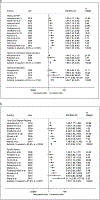Family history and pelvic organ prolapse: a systematic review and meta-analysis
- PMID: 33084962
- PMCID: PMC8086380
- DOI: 10.1007/s00192-020-04559-z
Family history and pelvic organ prolapse: a systematic review and meta-analysis
Abstract
Introduction and hypothesis: Numerous analytic observational studies assess family history as a risk factor for POP and report a wide range of associations. This review aims to systematically evaluate the role of family history of POP in relation to POP risk and its recurrence.
Methods: A review was performed of the PubMed/MEDLINE database with search criteria specifying family history, risk factors, POP, and their synonyms as title/abstract keywords, as well as MESH terms, up to March 2020. We aggregated evidence across studies with fixed effects (FE) and random effects (RE) meta-analysis.
Results: Forty-three articles underwent full-text review. Eighteen independent studies evaluating the relationship between family history of POP and POP risk in 3639 POP cases and 10,912 controls were eligible for meta-analysis. Four studies evaluating family history and POP recurrence in 224 recurrent cases and 400 non-recurrent cases were eligible for inclusion into another meta-analyses. A positive family history of POP is on average associated with 2.3- to 2.7-fold increased risk for POP (RE OR = 2.64; 95% CI = 2.07, 3.35) as well as a 1.4-fold increased risk for POP recurrence (FE OR = 1.44; 95% CI = 1.00, 2.08). Meta-analysis estimates of POP risk varied by study design, definition of family history, and model adjustment status. We found evidence that publication bias and recall bias are a possibility.
Conclusions: Family history of POP is a risk factor for both POP presence and recurrence. However, reported magnitudes may be overestimates due to confounding, recall bias, and publication bias.
Keywords: Family history; Meta-analysis; Pelvic organ prolapse; Primary prolapse; Prolapse recurrence; Systematic review.
Conflict of interest statement
Figures





Similar articles
-
Women with advanced pelvic organ prolapse and levator ani muscle avulsion would significantly benefit from mesh repair surgery.Ultrasound Obstet Gynecol. 2021 Apr;57(4):631-638. doi: 10.1002/uog.23109. Ultrasound Obstet Gynecol. 2021. PMID: 32898286
-
Association between delivery mode and pelvic organ prolapse: A meta-analysis of observational studies.Eur J Obstet Gynecol Reprod Biol. 2019 Apr;235:19-25. doi: 10.1016/j.ejogrb.2019.01.031. Epub 2019 Feb 6. Eur J Obstet Gynecol Reprod Biol. 2019. PMID: 30776548
-
Risk factors for the recurrence of pelvic organ prolapse: a meta-analysis.J Obstet Gynaecol. 2023 Dec;43(1):2160929. doi: 10.1080/01443615.2022.2160929. J Obstet Gynaecol. 2023. PMID: 36645334
-
International Urogynecology consultation chapter 2 committee 3: the clinical evaluation of pelvic organ prolapse including investigations into associated morbidity/pelvic floor dysfunction.Int Urogynecol J. 2023 Nov;34(11):2657-2688. doi: 10.1007/s00192-023-05629-8. Epub 2023 Sep 22. Int Urogynecol J. 2023. PMID: 37737436 Free PMC article. Review.
-
Association Between Striae and Pelvic Organ Prolapse in Women: A Systematic Review and Meta-Analysis.Int Urogynecol J. 2024 Aug;35(8):1561-1570. doi: 10.1007/s00192-024-05832-1. Epub 2024 Jun 12. Int Urogynecol J. 2024. PMID: 38864859
Cited by
-
International Urogynecological Consultation (IUC): pathophysiology of pelvic organ prolapse (POP).Int Urogynecol J. 2022 Jul;33(7):1699-1710. doi: 10.1007/s00192-022-05081-0. Epub 2022 Mar 10. Int Urogynecol J. 2022. PMID: 35267063 Review.
-
Association between the rs1036819 polymorphism of the ZFAT gene and pelvic organ prolapse: a case-control study.Int Urogynecol J. 2023 Oct;34(10):2611-2617. doi: 10.1007/s00192-023-05615-0. Epub 2023 Aug 3. Int Urogynecol J. 2023. PMID: 37535103
-
Identification of potential molecular mechanisms and therapeutic targets for recurrent pelvic organ prolapse.Heliyon. 2023 Aug 27;9(9):e19440. doi: 10.1016/j.heliyon.2023.e19440. eCollection 2023 Sep. Heliyon. 2023. PMID: 37681155 Free PMC article.
-
Psychometric evaluation and cross-cultural adaptation of the Australian Pelvic Floor Questionnaire (APFQ-IR) in Iranian reproductive age women.Sci Rep. 2023 Dec 27;13(1):23015. doi: 10.1038/s41598-023-50417-5. Sci Rep. 2023. PMID: 38155249 Free PMC article.
-
Impact on Sexual Function and Wish for Subsequent Pregnancy after Uterus-Preserving Prolapse Surgery in Premenopausal Women.J Clin Med. 2024 Jul 13;13(14):4105. doi: 10.3390/jcm13144105. J Clin Med. 2024. PMID: 39064144 Free PMC article.
References
-
- Weber AM, Richter HE. Pelvic organ prolapse. Obstet Gynecol 2005;106:615–34. 10.1097/01.AOG.0000175832.13266.bb. - DOI - PubMed
Publication types
MeSH terms
Grants and funding
LinkOut - more resources
Full Text Sources
Medical

